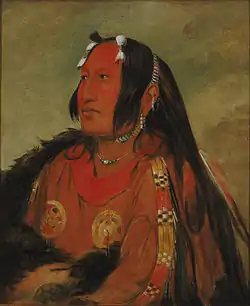Wi-jún-jon
Wi-jún-jon, also called Pigeon's Egg Head or The Light (1796–1872) was a Native American chief of the Assiniboine tribe. He is best known as the subject of a painting by George Catlin, depicting what happened after he was assimilated into white culture following a trip to Washington, D.C., in 1832.
_Going_To_and_Returning_From_Washington_-_Google_Art_Project.jpg.webp)
Pigeon's Egg Head | |
|---|---|
Wi-jún-jon | |
 Portrait by George Catlin, 1831 [1] | |
| Assiniboine leader | |
| Personal details | |
| Born | 1796 |
| Died | 1872 |
| Nickname(s) | The Light |
Caitlin wrote that Wi-jún-jon "exchanged his beautifully garnished and classic costume" for
a suit of "broadcloth, of finest blue, trimmed with lace of gold; on his shoulders were mounted two immense epaulets; his neck was strangled with a shining black stock and his feet were pinioned in a pair of water-proof boots, with high heels which made him 'step like a yoked hog'."[2]
A print based on the painting, showing Wi-jún-jon wearing Assiniboine dress and a Western suit, titled Wi-jún-jon, Pigeon's Egg Head, Going to Washington, returning to his house, became quite popular, appearing in a German magazine, Die Gartenlaube in 1853.[3]
References
- "Wi-jún-jon, Pigeon's Egg Head (The Light), a Distinguished Young Warrior by George Catlin". Smithsonian American Art Museum. Retrieved 2012-08-10.
- Gordon Morris Bakken (2011). The World of the American West. Taylor & Francis US. p. 190. ISBN 978-0-415-98995-4. Retrieved 10 August 2012.
- Pamela Kort; Max Hollein; Schirn Kunsthalle Frankfurt (2006). I like America: fictions of the Wild West. Prestel. ISBN 9783791360942. Retrieved 10 August 2012.